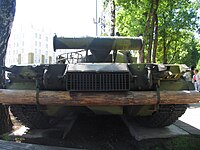
An armoured fighting vehicle (AFV) is an armed combat vehicle protected by armour, generally combining operational mobility with offensive and defensive capabilities. AFVs can be wheeled or tracked. Examples of AFVs are tanks, armoured cars, assault guns, self-propelled guns, infantry fighting vehicles (IFV), and armoured personnel carriers (APC).

A tank is an armoured fighting vehicle intended as a primary offensive weapon in front-line ground combat. Tank designs are a balance of heavy firepower, strong armour, and good battlefield mobility provided by tracks and a powerful engine; usually their main armament is mounted in a turret. They are a mainstay of modern 20th and 21st century ground forces and a key part of combined arms combat.

The Infantry Tank Mark II, best known as the Matilda, was a British infantry tank of the Second World War.

The infantry tank was a concept developed by the United Kingdom and France in the years leading up to World War II. Infantry tanks were designed to support infantrymen in an attack. To achieve this, the vehicles were generally heavily armoured to allow them to operate in close concert with infantry even under heavy fire. The extra armour came at the expense of speed, which was not an issue when supporting relatively slow-moving foot soldiers.

The FV101 Scorpion is a British armoured reconnaissance vehicle, and also a light tank. It was the lead vehicle and the fire support type in the Combat Vehicle Reconnaissance (Tracked), CVR(T), family of seven armoured vehicles. Manufactured by Alvis, it was introduced into service with the British Army in 1973 and was withdrawn in 1994. More than 3,000 were produced and used as a reconnaissance vehicle or a light tank.

The Cruiser tank Mk V or A13 Mk III Covenanter was a British cruiser tank of the Second World War. The Covenanter was the first cruiser tank design to be given a name. Designed by the London, Midland and Scottish Railway as a better-armoured replacement for the Cruiser Mark IV, it was ordered into production in 1939 before pilot models were built. Problems with the design became apparent only after production was under way.

British heavy tanks were a series of related armoured fighting vehicles developed by the UK during the First World War. The Mark I was the world's first tank, a tracked, armed, and armoured vehicle, to enter combat. The name "tank" was initially a code name to maintain secrecy and disguise its true purpose by making it appear to be a water transport vehicle for bringing water to the troops at the front line. The tank was developed in 1915 to break the stalemate of trench warfare. It could survive the machine gun and small-arms fire in "no man's land", travel over difficult terrain, crush barbed wire, and cross trenches to assault fortified enemy positions with powerful armament. Tanks also carried supplies and troops.

The Medium Mark B was a British tank of the First World War developed as a successor to the Whippet, but ultimately unsatisfactory and production was cancelled at the end of the war.

The M3 Scout Car was an American-produced armored car. The original M3 Scout Car was produced in limited numbers, while the improved M3A1 Scout Car saw wide service during World War II and after.

The Coventry armoured car (AFVW19) was a British four wheel drive armoured fighting vehicle developed at the end of the Second World War as a potential replacement for the lighter Humber and Daimler armoured cars.

The Lanchester armoured car was a British armoured car built on the chassis of the Lanchester "Sporting Forty", it saw wide service with the Royal Naval Air Service and British Army during the First World War. The Lanchester was the second most numerous World War I armoured car in British service after the Rolls-Royce armoured car.

The British Mark V tank was an upgraded version of the Mark IV tank.

The Type 63 is a Chinese armoured personnel carrier that entered service in the late 1960s. It was the first armoured vehicle designed in China without Soviet assistance. The design is simple and is comparable to other APCs of its time such as the M113.

Armoured Vehicle Royal Engineers (AVRE), also known as Assault Vehicle Royal Engineers is the title given to a series of armoured military engineering vehicles operated by the Royal Engineers (RE) for the purpose of protecting engineers during frontline battlefield operations.

The Bronco All Terrain Tracked Carrier (ATTC) is a twin chassis multi-purpose tracked articulated vehicle jointly developed by ST Kinetics and the Defence Science and Technology Agency (DSTA) for the Singapore Army. The variant which was in service as a UOR with the British Armed Forces is known as the Warthog.

The Delaunay-Belleville armoured car was a British armoured car built on the chassis of the luxury French Delaunay-Belleville tourer. It saw service with the Royal Naval Air Service in the early years of the First World War.
Christopher Frank Foss is a British military author. Since 1970 he has worked for the military publisher Jane's Information Group. He is editor of Jane's Armor and Artillery and co-editor of other Jane's editions.

The Killen-Strait armoured tractor was an experimental armoured tractor constructed by the United Kingdom in 1915. The vehicle consisted of the superstructure from a Delaunay-Belleville armoured car, with the turret removed, fitted on a tractor produced by the American company Killen-Strait. A predecessor to the Little Willie, the vehicle is sometimes described as the first tracked armoured vehicle.



















